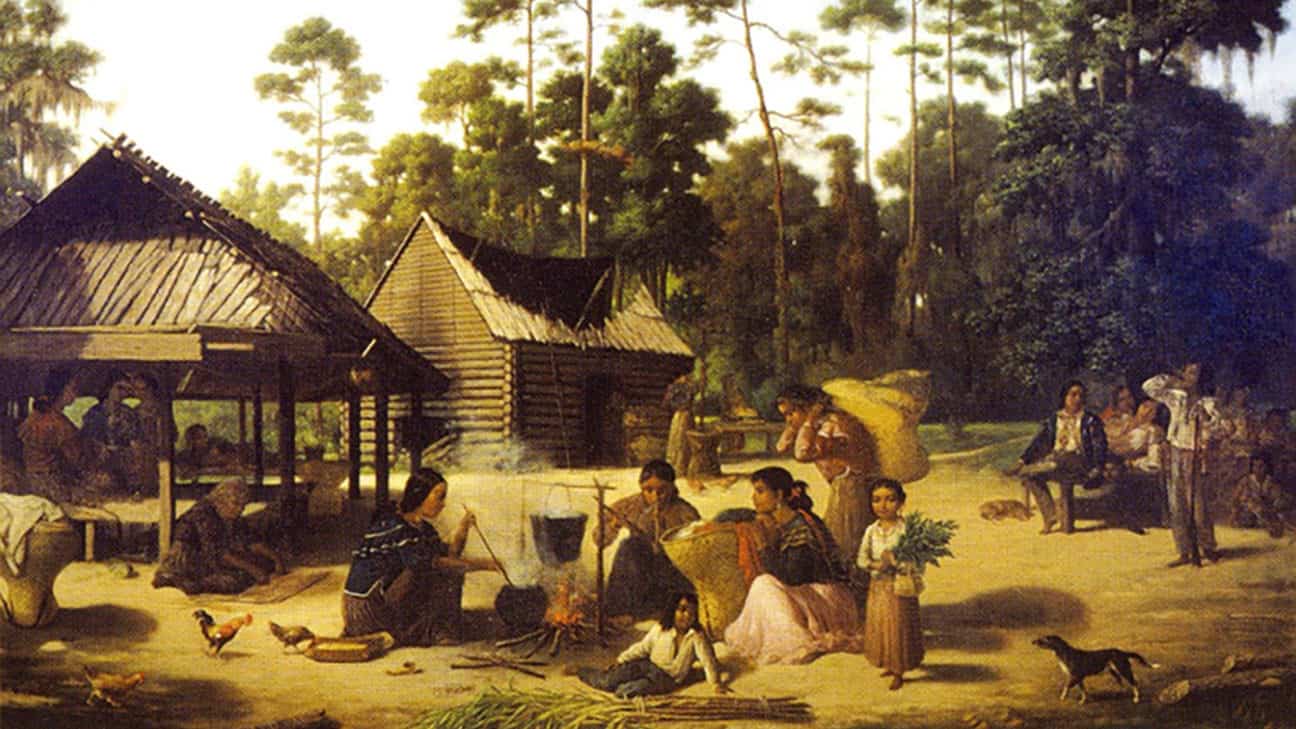
Choctaw Village near the Chefuncte by François Bernard, 1869
History of Choctaws in Louisiana: Successful in hunting, agriculture and trade
Iti Fabvssa
November 1, 2019
While it is known that the Choctaw homelands lie in Mississippi, did you know that Choctaws also have a history in Louisiana? The Choctaw people are connected to the Poverty Point culture. The Poverty Point World Heritage Site can be visited in Louisiana, along with the Tensas and other tribes who were adopted by the Choctaws. These small tribes were adopted due to population loss from warfare and disease brought by Europeans in their quest to colonize the tribes. Beginning in the mid-1700’s, Choctaws began moving into Louisiana from Mississippi.
There were various reasons for this movement into Louisiana. There was the issue of trade. There was a lot of tension among the Choctaws in Mississippi due to the split in who wanted to trade with the English and who wanted to trade with the French. This caused tension between the western Choctaws, who had allied with the French, and the eastern Choctaws who were allied with the English. To escape some of the tension, some Choctaws began moving into Louisiana, especially New Orleans, to buy, sell, and trade.
There were also issues of settlers encroaching on Native lands. The Choctaws settled in many locations across Louisiana and established several village locations, seasonal occupational areas, and cultural and religious sites. The Choctaw Nation Historic Preservation Department works to protect these sites even today. One area that Choctaws were attracted to was the piney woods, which was an area that held a similar environment to what was in Mississippi.
Choctaws prospered and grew in Louisiana until we became the most known native group in the region. We lived in small family groups, hunted for game and traded the game for European goods. We also survived by agricultural ventures. According to historians Kniffen, Gregory, and Stokes, many would plant “corn, pumpkins and potatoes, and raise chickens” (1994, pg. 95). Women dominated their own area of trade. The trading opportunities consisted of trading cane baskets and medicinal plants to plantations and markets; New Orleans was one large trading hub.
Choctaws were successful in establishing a new life in Louisiana. By 1700, tribes had developed a standard of living that was comparable with that of European newcomers. Among Choctaw people, opportunities for personal advancement were even greater due to our democratic society.
Choctaws remain in Louisiana to this day with the largest populations descended from eighteenth century Choctaw settlements in Rapides Parish and on the Ouachita River. These groups now compose the Jena Band of Choctaw.
The Jena Band of Choctaw Indians, who make up one the three federally recognized Choctaw Tribes, are in Jena, La Salle Parish, LA. They are the smallest of the Choctaw Tribes. Out of the Choctaw communities in Louisiana, the Jena Band is the community that has retained Choctaw language and crafts. They also practiced the old religion until the 1940’s.
Choctaw history in Louisiana may not be as well-known as that of Mississippi and Oklahoma, but it is of great importance. It teaches us that while we had the unfortunate event of removing from our homelands, we still thrived in whatever environment was thrown our way.
For more information about Louisiana Choctaws and for the source of the references in this article, refer to the book “The Historic Indian Tribes of Louisiana: From 1542 to the Present from 1994” written by Fred B. Kniffen, George A. Stokes, and Hiram F. Gregory.
About Iti Fabvssa
Iti Fabvssa seeks to increase knowledge about the past, strengthen the Choctaw people and develop a more informed and culturally grounded understanding of where the Choctaw people are headed in the future.
Additional reading resources are available on the Choctaw Nation Cultural Service website. Follow along with this Iti Fabvssa series in print and online.
Inquiries
If you have questions or would like more information on the sources, please contact Ryan Spring at [email protected].

